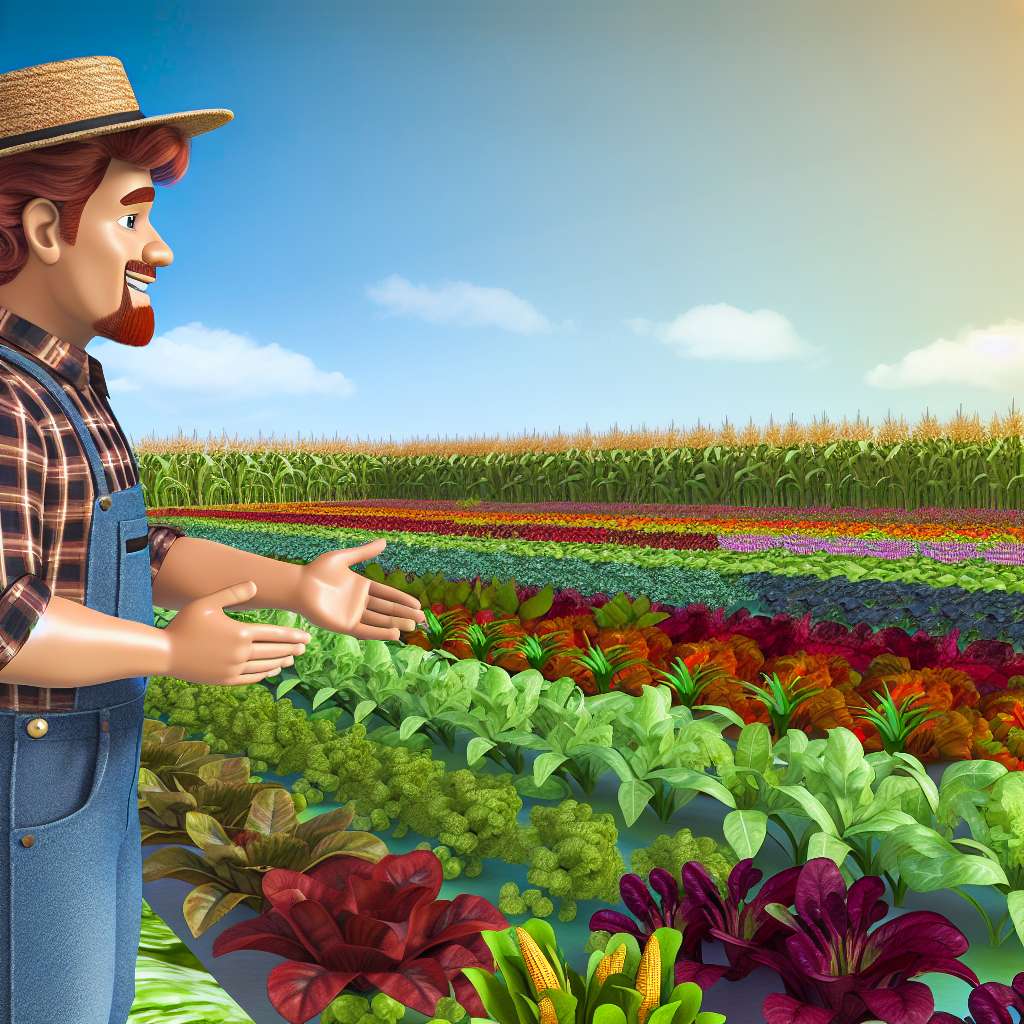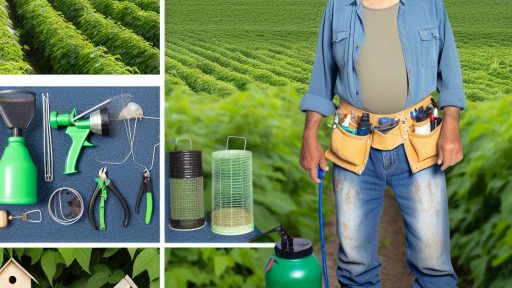Introduction to Diversification and Biodiversity in Farming
Diversification in farming involves growing a variety of crops and raising different livestock.
This practice enhances stability and resilience against market fluctuations.
Biodiversity refers to the variety of life on Earth, including ecosystems, species, and genetic variation.
Both diversification and biodiversity play crucial roles in sustainable agriculture.
Importance of Diversification
Diversification reduces the risk associated with monoculture practices.
It allows farmers to adapt to changing climates and pest pressures effectively.
Moreover, it can lead to improved soil health and nutrient cycling.
Farmers can generate multiple streams of income through diverse crops.
This approach can also attract a wider customer base.
Benefits of Biodiversity
Biodiversity ensures that ecosystems function properly and provide essential services.
It promotes natural pest control, reducing the need for chemical inputs.
A rich variety of species can improve pollination rates, enhancing crop yields.
Furthermore, biodiversity supports resilience against diseases and climate change.
Implementing Diversification and Biodiversity
Farmers can integrate cover crops to enhance soil fertility.
They should consider crop rotation to improve soil structure and prevent pests.
Transform Your Agribusiness
Unlock your farm's potential with expert advice tailored to your needs. Get actionable steps that drive real results.
Get StartedAdditionally, intercropping can maximize land use and yield benefits.
Incorporating native species can restore local ecosystems effectively.
Farmers should engage in sustainable practices to foster biodiversity.
Community and Economic Benefits
Diverse farming practices contribute to local economies by supporting small businesses.
They can create jobs in processing, marketing, and distribution sectors.
Community-supported agriculture (CSA) initiatives promote consumer engagement and education.
Furthermore, diversification can strengthen food security within communities.
Importance of Biodiversity for Agricultural Resilience
Enhancing Soil Health
Biodiversity significantly enhances soil health.
Diverse microbial communities improve nutrient cycling.
This diversity helps in breaking down organic matter.
Consequently, healthier soils can support higher crop yields.
Farmers can reduce their dependence on chemical fertilizers.
Controlling Pests and Diseases
Natural biodiversity provides essential pest control.
Diverse crops can host beneficial insects and pollinators.
As a result, pest populations remain balanced.
This reduces the need for chemical pesticides.
Additionally, resilient ecosystems can prevent disease outbreaks.
Climate Change Adaptation
Biodiversity aids in adapting to climate change impacts.
Different plant species can withstand varying climate conditions.
This variability helps secure food production amidst changes.
Diverse farming systems can better withstand extreme weather.
Thus, farmers face lower risks in unpredictable climates.
Economic Stability
Integrating biodiversity can provide economic stability.
Diverse farms can tap into various markets and products.
Showcase Your Farming Business
Publish your professional farming services profile on our blog for a one-time fee of $200 and reach a dedicated audience of farmers and agribusiness owners.
Publish Your ProfileAs a result, farmers can enhance their income streams.
This minimizes their economic dependence on single crops.
Furthermore, it promotes sustainable farming practices.
Preserving Ecosystems and Wildlife
Biodiversity supports local ecosystems and wildlife.
Healthy ecosystems contribute to cleaner air and water.
They also offer habitats for various species.
As a byproduct, this preserves genetic diversity.
Consequently, it fosters resilience in agricultural systems.
Economic Benefits of Crop and Livestock Diversification
Increased Revenue Streams
Diversifying crops and livestock creates multiple revenue sources for farmers.
This strategy allows them to withstand market fluctuations.
For instance, if one crop fails, others may thrive.
Additionally, having varied livestock can attract different customer bases.
Risk Management
Diversification reduces financial risks associated with single-crop farming.
It provides a safety net during bad weather or plant diseases.
Farmers can balance profits when one sector faces a downturn.
This approach ultimately leads to greater financial stability.
Improved Soil Health
Various crops and livestock enhance soil biodiversity.
This boosts soil health and productivity long-term.
As a result, diversified farming practices require fewer fertilizers.
Consequently, reduced input costs lead to higher profit margins.
Market Demand Fulfillment
Diversified farms meet local and regional market demands more effectively.
They can quickly adapt to changing consumer preferences.
For example, farmers can shift production based on seasonal trends.
This flexibility aids in capturing higher market prices.
Value-Added Products
Farmers can create value-added products through diversification.
These products often command higher prices than raw commodities.
Examples include jams, cheese, or artisanal meats.
Such offerings allow farmers to enhance their market presence.
Environmental Benefits
Diversification promotes ecological sustainability on farms.
Diverse crops can improve pest control and pollination.
This leads to a reduction in chemical pesticide use.
Ultimately, sustainable practices attract environmentally-conscious consumers.
Discover More: Integrating IoT Devices In Contemporary Agriculture
Strategies for Implementing Diversification on Modern Farms
Understanding Diversification
Diversification involves introducing a variety of crops and livestock on a single farm.
This strategy enhances resilience against market volatility.
It also improves soil health and reduces pest outbreaks.
Crop Rotation Techniques
Crop rotation is a key method in diversifying farming practices.
Farmers can alternate between different crops each season.
This practice enhances soil fertility and disrupts pest life cycles.
For instance, rotating legumes can increase nitrogen levels in the soil.
Showcase Your Farming Business
Publish your professional farming services profile on our blog for a one-time fee of $200 and reach a dedicated audience of farmers and agribusiness owners.
Publish Your ProfileAgroforestry Practices
Agroforestry combines agriculture with forestry practices.
Farmers can plant trees alongside crops or livestock.
This method improves biodiversity and provides additional income streams.
Furthermore, trees can help with soil erosion and water retention.
Integrated Pest Management
Integrated Pest Management (IPM) includes various pest control methods.
Farmers can use biological, cultural, and mechanical controls.
This approach reduces reliance on chemical pesticides.
Ultimately, it fosters a healthier ecosystem on the farm.
Livestock Diversification
Diversifying livestock types can enhance farm productivity.
For example, raising chickens alongside crops can yield organic fertilizer.
Additionally, integrating different livestock species can reduce competition for resources.
This leads to a more balanced farming ecosystem.
Community Supported Agriculture
Community Supported Agriculture (CSA) models can support diversification.
These programs connect local farmers directly with consumers.
Such relationships can promote the sale of diverse farm products.
Moreover, they strengthen community ties and provide reliable income for farmers.
Utilizing Technology in Diversification
Modern technology can aid in implementing diversification strategies.
For instance, precision agriculture tools can optimize crop yields.
Additionally, data collection can help farmers make informed decisions.
Using drones and sensors can also monitor crop health efficiently.
Gain More Insights: Sustainable Farming Innovations For Higher Productivity
Case Studies: Successful Diversified Farming Operations
Frost Valley Farm: A Model of Diversity
Frost Valley Farm thrives on a blend of crops and animals.
Their multifaceted approach yields vegetables, fruits, and livestock.
This variety not only enhances biodiversity but also improves resilience.
Farmers at Frost Valley rotate between crops to maintain soil health.
This method reduces pest outbreaks and disease occurrences effectively.
Moreover, the farm educates visitors about sustainable practices.
The Green Pastures Initiative
Green Pastures Initiative showcases the power of polyculture.
They integrate various species of plants and animals in the same space.
This technique cultivates a healthy ecosystem on the farm.
In addition, it increases productivity and nutrient cycling.
Farmers report lower inputs for fertilizers and pest control.
Consequently, their profits have improved significantly.
Harvest Moon Farms: Strength in Community
Harvest Moon Farms emphasizes community-supported agriculture.
Families buy shares in the farm’s produce each season.
This model fosters a direct connection between consumers and farmers.
Furthermore, diversifying crops meets various customer preferences.
The farm also conducts workshops to share best practices.
As a result, they build a supportive network among local producers.
Sunny Fields Agroforestry
Sunny Fields adopts agroforestry techniques to maximize land use.
Showcase Your Farming Business
Publish your professional farming services profile on our blog for a one-time fee of $200 and reach a dedicated audience of farmers and agribusiness owners.
Publish Your ProfileThey combine trees with crops, enhancing biodiversity and soil quality.
This method also improves water retention in the soil.
Farmers notice increased yields over conventional methods.
In turn, this leads to a healthier farming ecosystem overall.
Moreover, the agroforestry system creates habitats for wildlife.
Riverbend Ranch: Regenerative Practices
Riverbend Ranch practices regenerative agriculture to restore ecosystems.
They focus on soil health and biodiversity preservation.
This ranch rotates livestock to promote pasture regeneration.
Consequently, pastures recover and enhance their productivity.
The farm also implements cover cropping to prevent soil erosion.
Overall, these methods contribute to long-lasting sustainability.
Uncover the Details: Integrating Livestock to Enhance Farm Productivity

Role of Sustainable Practices in Enhancing Biodiversity
Improving Soil Health
Sustainable practices directly improve soil health.
Healthy soil supports a diverse range of organisms.
This diversity contributes to a balanced ecosystem.
Moreover, soil enrichment enhances crop yield.
Ultimately, this leads to sustainable food production.
Promoting Crop Diversity
Farmers adopting sustainable methods promote crop diversity.
Diverse crops are less susceptible to pests and diseases.
This resilience reduces the need for chemical pesticides.
Consequently, ecosystems become healthier over time.
In addition, varied crops improve soil structure and fertility.
Encouraging Beneficial Species
Integrating sustainable practices encourages beneficial species.
Pollinators play a vital role in crop production.
Moreover, natural predators help control pest populations.
Farmers can provide habitats that attract these species.
This creates a self-sustaining agricultural ecosystem.
Water Conservation and Biodiversity
Sustainable practices often incorporate water conservation methods.
Effective water management supports diverse plant life.
This careful management leads to healthier aquatic ecosystems.
Healthy water sources enhance overall biodiversity.
Consequently, farms become more resilient to climate variations.
Community Engagement and Knowledge Sharing
Engaging local communities fosters increased biodiversity understanding.
Farmers share practices that support sustainable farming.
Collaboration leads to innovative solutions for biodiversity challenges.
Furthermore, local knowledge can enhance agricultural practices.
Thus, communities play a crucial role in biodiversity efforts.
Uncover the Details: Financing Options To Expand And Sustain Your Farm Business
Impact of Biodiversity on Soil Health and Ecosystem Services
Enhancing Soil Fertility
Biodiversity significantly enhances soil fertility.
Diverse organisms contribute to nutrient cycling.
Showcase Your Farming Business
Publish your professional farming services profile on our blog for a one-time fee of $200 and reach a dedicated audience of farmers and agribusiness owners.
Publish Your ProfileHealthy soil contains a variety of microbes, fungi, and invertebrates.
These organisms break down organic matter efficiently.
As a result, they release essential nutrients into the soil.
This process boosts plant growth and yields.
Improving Soil Structure
Various soil-dwelling organisms improve soil structure.
For instance, earthworms aerate the soil by burrowing.
This activity allows water and oxygen to penetrate more deeply.
Additionally, plant roots help bind soil particles together.
Consequently, this reduces erosion and improves water retention.
Promoting Pest and Disease Control
Biodiversity naturally regulates pests and diseases.
Diverse plant varieties attract beneficial predators.
These predators include ladybugs and lacewings.
Furthermore, a healthy ecosystem can suppress pathogen outbreaks.
This contributes to reduced pesticide use on farms.
Contributing to Ecosystem Services
Biodiversity provides essential ecosystem services.
These services include pollination, water filtration, and carbon storage.
For example, bees and butterflies promote plant reproduction.
Healthy wetlands filter pollutants from water sources.
Moreover, diverse ecosystems capture carbon, helping combat climate change.
Increasing Resilience to Environmental Stressors
A diverse farm ecosystem can better withstand environmental stressors.
For instance, varied crops can endure climate fluctuations.
This adaptability leads to more consistent yields.
In addition, such diversity enhances soil resilience against erosion.
Ultimately, it supports long-term agricultural sustainability.
Future Trends in Diversification and Biodiversity in Agriculture
Embracing Technology for Biodiversity
Farmers increasingly use technology to enhance biodiversity.
For instance, precision agriculture helps monitor crop health and biodiversity levels.
Additionally, drones assist in assessing field conditions efficiently.
As a result, farmers can make informed decisions about plant varieties.
Moreover, technology can help track endangered species on farms.
Integrating Agroecology Practices
Agroecology promotes a holistic approach to farming.
This practice enhances ecosystem services beneficial for crop production.
Farmers can implement crop rotations to improve soil health.
Furthermore, intercropping can enhance pest control naturally.
Such practices not only boost productivity but also sustainability.
Enhancing Pollinator Habitats
Increasing awareness of pollinators drives farm diversification efforts.
Farmers can plant wildflowers and native plants to attract pollinators.
These habitats support not only bees but also other beneficial insects.
Consequently, farms benefit from improved pollination rates and yield quality.
Investing in Organic Farming
Organic farming is a growing trend that fosters biodiversity.
This method avoids synthetic pesticides and fertilizers detrimental to ecosystems.
Showcase Your Farming Business
Publish your professional farming services profile on our blog for a one-time fee of $200 and reach a dedicated audience of farmers and agribusiness owners.
Publish Your ProfileThus, organic farms often showcase richer soil and diverse microbial life.
Furthermore, they promote a wider variety of crops and livestock.
Farmers increasingly recognize the market demand for organic produce.
Collaborative Farming Initiatives
Collaboration among farmers enhances biodiversity through shared resources.
Cooperatives can help farmers access diverse seeds and practices.
Such initiatives lower costs while increasing access to knowledge.
Additionally, they foster strong community ties among farmers.
Ultimately, collaborative efforts lead to more resilient farming systems.
Incorporating Climate Resilience Strategies
Farmers are adopting climate-resilient practices to combat environmental changes.
Diverse cropping systems enhance resilience against pests and diseases.
Moreover, these systems can better withstand extreme weather events.
Consequently, farmers improve their adaptive capacity and long-term productivity.
Climate-smart agriculture is becoming increasingly critical for future farming.
Additional Resources
Regenerative agriculture in Europe – A critical analysis of …




